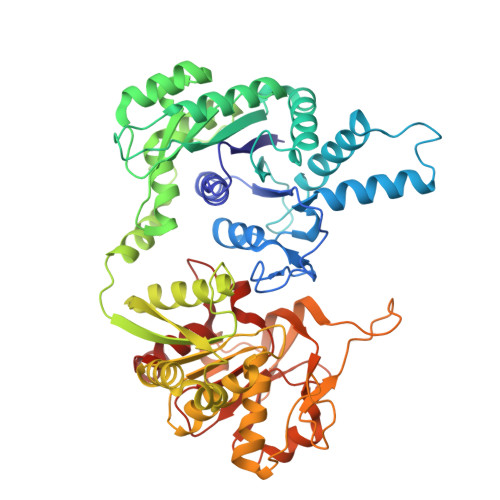Structural basis for ligand binding modes of CTP synthase.
Zhou, X., Guo, C.J., Chang, C.C., Zhong, J., Hu, H.H., Lu, G.M., Liu, J.L.(2021) Proc Natl Acad Sci U S A 118
- PubMed: 34301892
- DOI: https://doi.org/10.1073/pnas.2026621118
- Primary Citation of Related Structures:
7DPT, 7DPW, 7WIZ, 7WJ4 - PubMed Abstract:
Cytidine triphosphate synthase (CTPS), which comprises an ammonia ligase domain and a glutamine amidotransferase domain, catalyzes the final step of de novo CTP biosynthesis. The activity of CTPS is regulated by the binding of four nucleotides and glutamine. While glutamine serves as an ammonia donor for the ATP-dependent conversion of UTP to CTP, the fourth nucleotide GTP acts as an allosteric activator. Models have been proposed to explain the mechanisms of action at the active site of the ammonia ligase domain and the conformational changes derived by GTP binding. However, actual GTP/ATP/UTP binding modes and relevant conformational changes have not been revealed fully. Here, we report the discovery of binding modes of four nucleotides and a glutamine analog 6-diazo-5-oxo-L-norleucine in Drosophila CTPS by cryo-electron microscopy with near-atomic resolution. Interactions between GTP and surrounding residues indicate that GTP acts to coordinate reactions at both domains by directly blocking ammonia leakage and stabilizing the ammonia tunnel. Additionally, we observe the ATP-dependent UTP phosphorylation intermediate and determine interacting residues at the ammonia ligase. A noncanonical CTP binding at the ATP binding site suggests another layer of feedback inhibition. Our findings not only delineate the structure of CTPS in the presence of all substrates but also complete our understanding of the underlying mechanisms of the allosteric regulation and CTP synthesis.
- School of Life Science and Technology, ShanghaiTech University, Shanghai, 201210, China.
Organizational Affiliation:


















